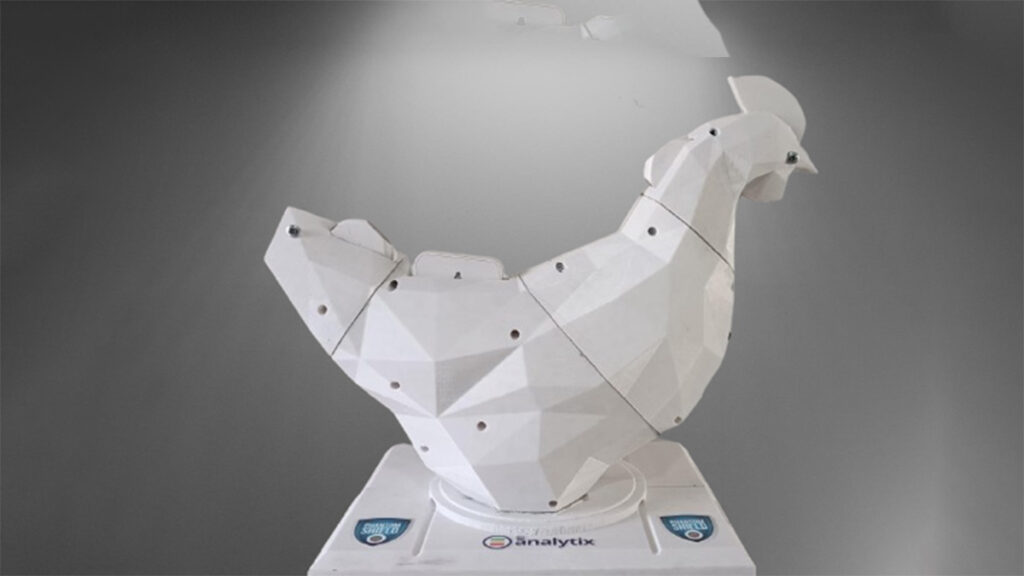IoT is significantly altering the business landscape across multiple industries with agriculture being a prime use-case. Real-time data solutions are increasingly being used for decision-making and an example of such an innovation is one being trailed by GSS Analytix’s called Pollobot.
GSS Analytix’s innovative Pollobot is an IoT enabled device focused on poultry farming to enhance today’s monitoring and management of poultry through real-time data collection on crucial environmental variables like temperature, humidity, light, noise, and air quality. Pollobot’s capabilities also extend to providing smart alerts, enabling data visualisation, and initiating automated actions based on specific data thresholds. Not only is this better for the health of the poultry, it also increases efficiency, productivity, and sustainability.
The development of the Pollobot prototype was inspired directly by the needs of the industry. GSS Analytix joined forces with Don Pollo, a leading poultry farming operation in Colombia and worked together to integrate the right sensors and technology into the design. The design looks like a chicken meaning it fits well onto farms! Additionally, the team at Don Pollo worked on a digital configuration file for the Reveal platform that specifies the most important metrics and alerts that a Poultry farming operation must track.
After successful pilot implementations Q4 2023 the Pollobot solution will be ready for market deployment Q1 2024 initially in Colombia, Chile and Brasil and for the US and main European markets in Q3 2024.
Some of the transformative impacts of Pollobot in agriculture are:
- Enhanced Monitoring and Control: Pollobot’s ability to continuously monitor critical environmental parameters like temperature, humidity, noise, air quality, and light ensures that poultry farms can maintain optimal conditions for bird growth and health. This precise control can lead to better production rates and healthier poultry.
- Data-Driven Decision Making: By collecting and analysing data from various sensors, Pollobot enables farmers to make informed decisions based on real-time information. This data-driven approach can improve operational efficiency, reduce costs, and increase yields.
- Early Warning and Preventive Action: The system can alert farmers to potential issues before they become significant problems. For example, early detection of disease symptoms or environmental stressors can lead to quicker interventions, reducing the risk of widespread health issues among the birds.
- Automation of Routine Tasks: Pollobot can automate various tasks, such as adjusting environmental controls based on sensor data or scheduling feeding and watering. This automation reduces the labour required for daily operations and allows farm staff to focus on more critical tasks.
- Resource Optimisation: Through efficient monitoring and management, Pollobot helps in optimising the use of resources such as feed, water, and energy. This not only cuts down on costs but also promotes sustainable farming practices.
- Improved Record Keeping and Compliance: The device provides detailed records of environmental conditions and farm operations. This data is crucial for compliance with health and safety regulations and can be invaluable for audits and certifications.
- Scalability and Flexibility: As poultry farms grow or change their operations, Pollobot can scale accordingly. Its flexibility allows for integration with other technologies and adaptation to different farming practices or business models.
- Enhanced Product Quality and Animal Welfare: By maintaining optimal growing conditions, Pollobot contributes to improve animal welfare and product quality, which is increasingly important to consumers.
The future landscape shaped by IoT
The continuous evolution and integration of IoT technologies across sectors forecasts a future of interconnected, efficient, and adaptable and redefined business operations and strategies.
Apart from operational efficiency, IoT also plays a crucial role in promoting sustainable business practices. By enabling precise monitoring and control of resources, IoT aids in reducing waste, lowering carbon footprints, and promoting environmental stewardship. Businesses are increasingly leveraging IoT to not only enhance profitability but also to align with global sustainability goals.
While IoT presents numerous opportunities, it also brings challenges such as data security, privacy concerns, and the need for skilled personnel to manage and interpret IoT data.
The rapid growth of the IoT sector, coupled with innovative applications like GSS Analytix’s Pollobot, underscore the profound and expanding influence of IoT technology in the business world.
Market size and traction
The size of the global poultry market in 2023 is estimated to be $378.84 billion, reflecting a compound annual growth rate (CAGR) of 7.6% from the previous year’s value of $352.02 billion.
The enterprise IoT market showed growth of 21.5% in 2022, reaching $201 billion. The global market size for IoT stood at an impressive $1.02 trillion in 2023, with forecasts predicting a surge to $2.06 trillion by 2028, exhibiting a compound annual growth rate (CAGR) of 15.12%. Additionally, the number of global IoT connections expanded by 18% in 2022 to 14.3 billion active endpoints, with projections for 2023 indicating a further increase of 16%, reaching 16.7 billion. This growth trajectory underscores the rapidly increasing integration of IoT across multiple business sectors.
Hélène is co-founder of the SENSE Consortium and Juan Bernal is CEO of GSS Analytix.
